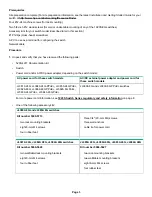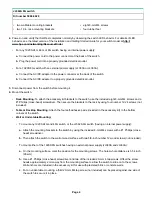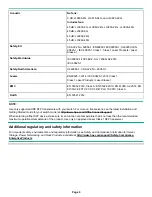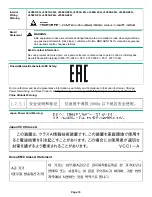
CAUTION:
• Ensure that the power source circuits are properly grounded. To connect to the AC power source, use the power
cord supplied with the switch.
• If your installation requires a different power cord than the one supplied with the switch and/or power supply, be
sure that the cord is adequately sized for the current requirements of the switch. In addition, be sure to use a
power cord displaying the mark of the safety agency that defines the regulations for power cords in your country/
region. The mark is your assurance that the power cord can be used safely with the switch and power supply.
• When installing the switch, the AC outlet should be near the switch and easily accessible in case the switch must
be powered off.
• Ensure that the switch does not overload the power circuits, wiring, and over-current protection. To determine the
possibility of overloading the supply circuits:
1.
add together the ampere ratings of all devices installed on the same circuit as the switch
2.
compare the total with the rating limit for the circuit.
The maximum ampere ratings are usually printed on the devices near the AC power connectors.
• Do not install the switch in an environment where the operating ambient temperature exceeds its specification.
• Ensure that the air flow around the switch is not restricted. Leave at least 7.6 cm (3 inches) for cooling.
Installing a 1920S switch
CAUTION:
To help avoid personal injury or product damage, see the
Installation Precautions
on page 1 and note the
reference to
Additional regulatory and safety information
on page 9.
The information in this section describes how to install your switch when your network includes a DHCP or BootP service.
For more detailed instructions and information on installing your switch, including installation when the switch cannot
access a DHCP or BootP service, see the latest edition of the
Installation and Getting Started Guide
for your switch at
http://www.hpe.com/support/hpesc
.
IMPORTANT:
When the switch powers up in the factory default configuration, it attempts to obtain IP addressing from a DHCP
server. If the switch obtains a DHCP address, then you must determine that address. To learn the assigned IP
addressing, access your network DHCP or BootP server files or use LLDP (Link Layer Discovery Protocol)
show
commands on a connected device (such as another switch). If the switch does not receive IP addressing from a
DHCP or BootP server within 90 seconds of power-on, it defaults to a static IP address and subnet mask of
192.168.1.1/24. In this case, you must reconfigure the PC IP addressing to communicate with the switch. The
HPE
OfficeConnect 1920S Installation and Getting Started Guide
includes the switch factory default configuration and
other information on initial switch configuration when DHCP or BootP service is not available. (See the latest edition
at
http://www.hpe.com/networking/ResourceFinder
.)
NOTE:
The HPE OfficeConnect 1920S Switch Series JL380A 8-port, JL381A 24-port, and JL382A 48-port non-PoE+ models
have a fan-free design, making them quiet for office deployments. A warmer than normal enclosure is a standard state of
operation for a fan-free switch.
Although the top of the switch enclosure may feel warm to the touch, it has no effect on functionality or performance of the
product.
Page 2





























